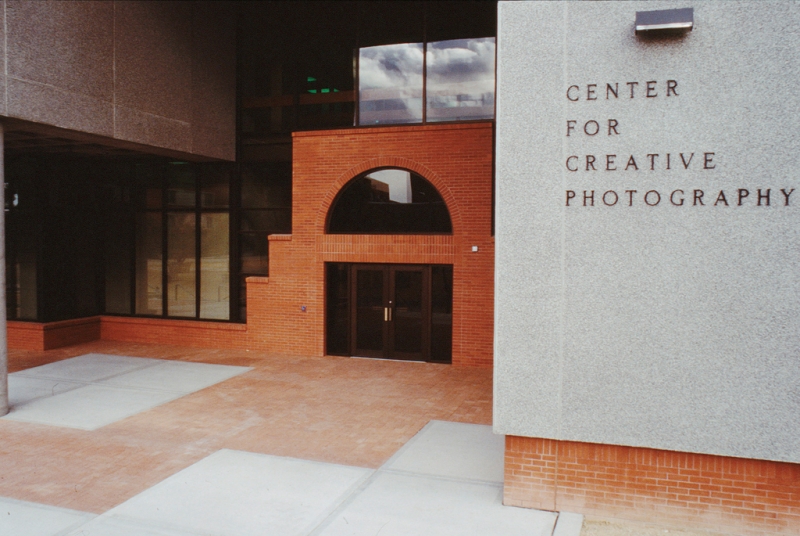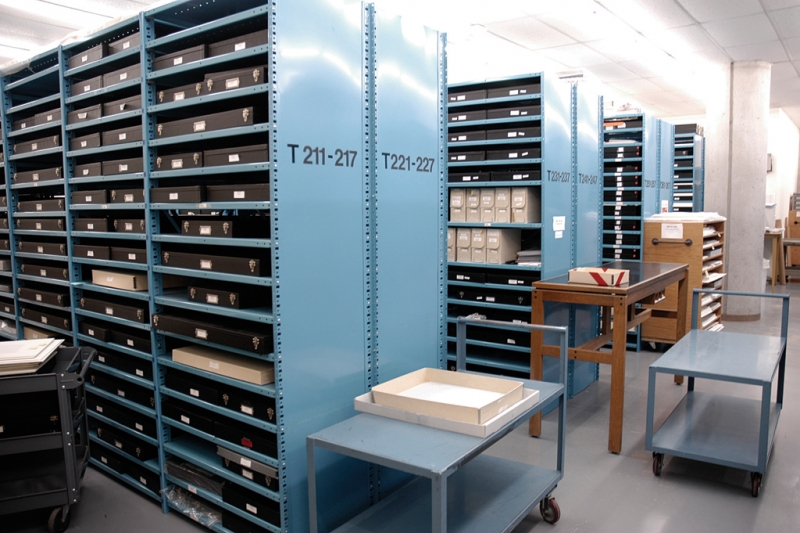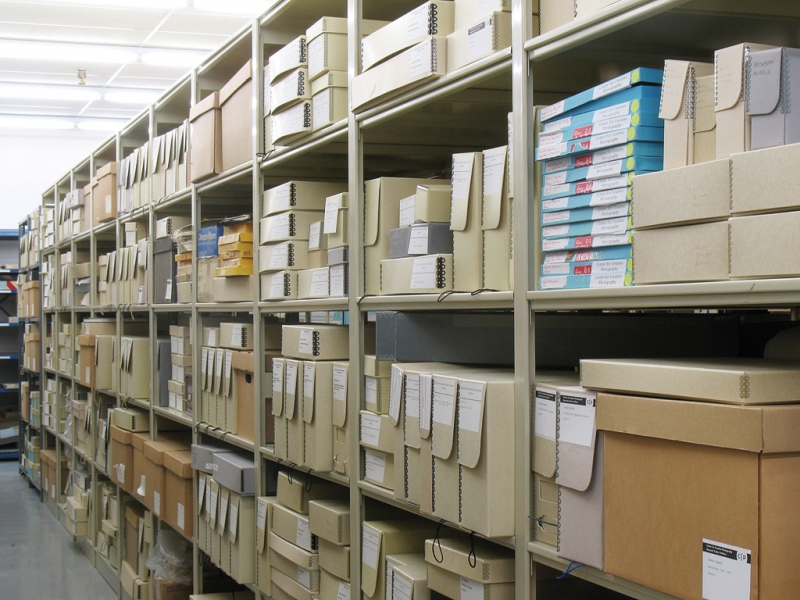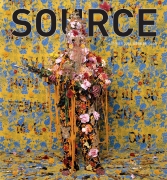In Perpetuity
Mary Warner Marien talks to Amy Rule, the head of research at the Center for Creative Photography in Arizona, about the Center's role in receiving and preserving photographers' work.
Issue 55 Summer 2008
View Contents ▸
The Center for Creative Photography, located on the campus of the University of Arizona at Tucson, celebrated its 30th anniversary in 2005. Ansel Adams was among its founders, and his emphasis on public access guides the institution. CCP take pride in holding more archives and individual works by 20th-century North American photographers than any other museum in the nation.' Their research collection features the archives of Ansel Adams, Lola Alvarez Bravo, Richard Avedon, Louise Dahl-Wolfe, W. Eugene Smith, and Edward Weston among others. These archives include not only photographs, but also negatives, albums, work prints, manuscripts, audio-visual material, contact sheets, correspondence and memorabilia.' Amy Rule, who began working as a librarian and archivist at CCP in 1981, became Head of Research in 2005.
Mary Warner Marien: CCP is best known as the museum and archive founded by Ansel Adams. Did Adams originally envision an archive for American photographers or photographers of the American West? Did he delimit his vision at all?
Amy Rule: Essentially, Adams had been looking for an institution to provide access to and preserve his life's work. He approached several, but was told that museums must relegate most of their collections to storage. Access for research was way down at the bottom of the list of priorities, way after exhibitions, for example. Adams did not stress the geographical/US bias you suggest. He was looking for a new way of institutionalizing creative photography so that the field could grow and support new study and appreciation.
Mary Warner Marien: Your list of major collections includes that of Robert Heinecken, who died in 2006. Did you acquire the materials after his death, or were you able to work with him (and Joyce)? When is the ideal time for a photographer to start thinking about archiving materials?
Amy Rule: We are particularly interested in establishing relationships with living, working photographers. Robert Heinecken is a good example. We began working with him to develop and fine-tune his archive while he was still teaching. He retired from his job at UCLA and moved to Chicago in the mid-1990s. It was natural for him to sort and evaluate his work at that time, so we received a large portion of his archive. Since his death, we continue working with his estate to round out his archive so that it is completely representative of his career. Over the course of a twenty year relationship with Heinecken, we were able to inform him of the research value of various components in his archive, influencing his decisions about what to save and what to discard. We also were able to benefit from his commentary about artistic intent and chronology. In instances when the photographer is no longer living, we make every effort to preserve the record of her/his decisions about the finished product of their art. For example, we do not routinely allow printing from negatives unless we are able to parse the artist's wishes. In most cases, printing is not allowed because the typical photographer made all the crucial decisions about the appearance of a photograph during the printing process. No one else could made the same decisions. Center for Creative Photography, Arizona
Center for Creative Photography, Arizona
Mary Warner Marien: Like many American artists in the second half of the twentieth century, Heinecken used some non-traditional materials and methods to produce his work. How did CCP greet the challenge of preserving these items?
Amy Rule: First of all, we were fortunate to be able to discuss these issues with the artist himself and to record his wishes when fragility, transitory materials, and presentation style were issues. Another benefit of archives is that they often contain documentation about the components of a work of art, their composition, their installation, their history, and we consult these records as needed. It is true that three-dimensional pieces constructed sometimes as site-specific objects are challenging to preserve.
Mary Warner Marien: Since 1975, when CCP was founded, the sale prices for prints by famous photographers have grown a great deal. Some Edward Weston prints have sold for more than a million dollars. Can CCP continue to collect prints and docs from E. Weston, P. Strand, G. Winogrand, L. Freidlander, etc.?
Amy Rule: Throughout its history, CCP has had to work on innovative ways to acquire priceless treasures with limited funding. We have had success with an approach that combines purchase and gift. This allows us to compensate living photographers for their life's work through a combination of cash and the added value of our commitment to preserve their work in perpetuity. The story of the dramatic rise in market value for photography is well documented in the records of the pioneering photo galleries run by Helen Gee, Lee Witkin, and Harold Jones (Limelight, Witkin Gallery, and LIGHT Gallery). The Center can't compete with the volatile marketplace, but we can offer the infrastructure of a research institute dedicated to providing access and preserving. It is also important to note that archives inhabit a different realm. A letter by Albert Einstein recently sold for $404,000 at auction, but no similar market exists for letters by the greatest figures in photography.
Mary Warner Marien: Are people more willing to donate documents and photographs to institutions like CCP, which make materials available to the public without cost?
Amy Rule: I am continually amazed by the generosity of photographers and others involved in the world of photography. When it comes down to a matter of adding another chapter to the history of photography people are often eager to share what they have, whether it is ephemera, letters, contact sheets, or simply memories. We are actively collecting oral histories as a way of adding to our knowledge through digital storage rather than shelf space.
Mary Warner Marien: How do the U.S. tax laws regarding donations of prints and documentary materials benefit donors?
Amy Rule: I am not a tax attorney, but I do advise potential donors that depending on their tax status and their relationship to the artist, the donation of art to a charitable, non-profit institution can be advantageous. The laws have been changing, making certified, timely appraisals more necessary. It is a complicated business.
Mary Warner Marien: Has the widespread turn to digital photography changed how CCP collects work?
Amy Rule: To date, whether or not an artist creates born digital' works of art has not influenced our decision to acquire. I do, however, anticipate difficulty in the future being able to state with certainty anything about the process an artist used to create a photograph. That will be a change from today when we can study the negatives, contact prints, and work notes of an artist and reconstruct the creative process. Another facet to the digital world, is that we are in a constant catch-up game to keep abreast of developments in regard to how we preserve the information about our collections. Database management, sharing, and serving are key elements of debate. The other area of huge change is the world of publishing. In the past, our staff would supply slides or transparencies to publishers of books on photography. This revenue stream enabled us to fund several staff positions. Now, publishers demand scans that must be emailed the same day and these files are huge. Storage issues, naming issues, file management and other issues about certifying reliability and authenticity are keeping us up at night. The second floor vault; a view of the photography storage vault showing typical boxes for matted photographs
The second floor vault; a view of the photography storage vault showing typical boxes for matted photographs
Mary Warner Marien: I have used CCP's online finding guides and lists of works in major collections as handy reviews of photographers' works. I have the impression that CCP has moved aggressively to put information on the collection online. Did CCP make such a decision? When? Why?
Amy Rule: It is essential to make information about our collections available through easily accessed websites. We have a five year plan that spells out a strategy to scan all the photographs, link these images to cataloging records, and serve the data to the public through our website. Another part of the plan is to create finding aids linked to scanned archival objects and have these also searchable and accessible on the web. We are currently scanning about 10,000 photographs per year, but the public interface of our cataloging system is not ready to be shared. When it is, we will have a huge amount of information to share along with ways to answer our most frequent requests orders for scans, exhibition loans, calendar events, and reference inquiries.
Mary Warner Marien: CCP originated the exhibition Margrethe Mather and Edward Weston: A Passionate Collaboration, which drew on the photographs, correspondence, and other sources unique to the CCP collection. Are there other intellectual and/or passionate pairings to be found in your archive?
Amy Rule: Yes, many more! And someday we will pay more attention to the passionate pairings. Hansel Mieth and Otto Hagel German emigrants to Northern California who together fought for social causes both with actions and with their documentary photography. Beaumont and Nancy Newhall both of them scholars and writers who through their friendships and collaborations influenced the evolution of the photography world. Todd and Lucille Webb fifty years of mutually-supportive married life, travel, and friendships in the arts world. Harry and Eleanor Callahan the classic, passionate relationship between artist and muse. The third floor vault; a view inside the archives vault showing the typical storage of a photographer's personal papers and photographic materials
The third floor vault; a view inside the archives vault showing the typical storage of a photographer's personal papers and photographic materials
Mary Warner Marien: And speaking of passion, does CCP accept visual and documentary materials under the condition that they be embargoed for a certain number of years?
Amy Rule: As caretakers of recently created historic documents, we must be sensitive to the rights of privacy and confidentiality. An archive with medieval illuminated manuscripts scarcely needs to be concerned about privacy, but our collections contain love letters, academic transcripts, psychiatrist's evaluations, and other documents that could cause embarrassment or pain if they became public. The law allows us to make these available for research, but as a way to prevent in appropriate use when so many constituents may still be alive, we impose an internal restriction against use before the document is twenty-five years old. After that, unless prohibited by law (as in the case of academic transcripts) we allow scholars to read, but not to copy without the permission of the party involved.
Mary Warner Marien: You mentioned that you recently acquired a hearing aid for the collection? Whose was it and did you accept it? Has CCP acquired other unusual material objects?
Amy Rule: The hearing aid was part of the Max Yavno Archive. It is difficult to say whether we would have received the hearing aid if the artist had been alive to make decisions about his archive. We often receive odd items when the circumstances of the artist's death resulted in a chaotic period before acquisition. You can never be sure about an object's meaning or importance if a well-meaning friend or family member packed it up without a note along with the obviously significant item. On the other hand, we have other odd items that were deliberately and carefully included by the artist a rattlesnake tail in a letter from Georgia O'Keeffe; pressed flowers in a letter from Tina Modotti; cocktail napkins with ballpoint pen notes about conversations with Robert Heinecken; a large human molar tooth in the Frederick Sommer Archive.
Mary Warner Marien: If you have been anxious to answer one question about the collection, please phrase it and answer it.
Amy Rule: Where is it all going? I believe that our defense of the material collections telling the history of photography will be increasingly more valuable in the future when virtual experiences start to feel shallow, second-hand, and thin. Why spend so much money on space, storage, and preservation when you can simply scan everything? The material collections offer the opportunity for us to experience and engage with something of undoubted authenticity. The encounter with art and archives can change our lives and will certainly result in fresh ideas through those many intangible connections from viewer to object.






